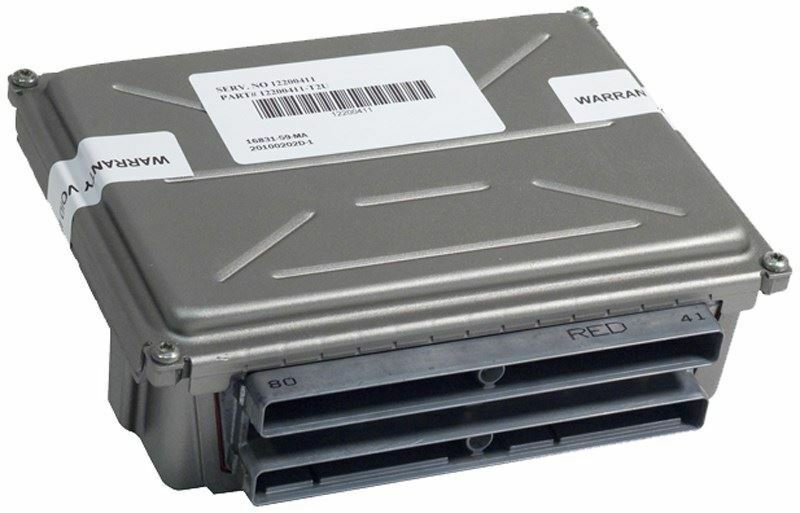Is your 1998 Pontiac Bonneville suffering from mysterious engine issues, poor fuel economy, or a persistent Check Engine Light? The Powertrain Control Module (PCM), the electronic brain of your vehicle, is often the culprit. A failing PCM can cause a cascade of frustrating problems that can be difficult to diagnose. This replacement Powertrain Control Module, part number 09356741, is the definitive solution to restore your vehicle’s performance, reliability, and drivability.
Unlike generic modules from a salvage yard, this unit is professionally programmed to your vehicle’s specific Vehicle Identification Number (VIN). This critical step ensures that the module communicates flawlessly with your engine, transmission, and all other onboard systems. We install the latest official GM software updates available for your vehicle, which can resolve factory bugs and improve overall operation. This means you’re not just getting a replacement part; you’re getting a component that’s optimized for your exact car.
Common Symptoms of a Failing 1998 Bonneville PCM
If you’re experiencing any of the following issues, a faulty PCM could be to blame. This module is designed to correct these and other related problems, getting you back on the road with confidence.
- ✔ Check Engine Light: The light is illuminated, and you may have error codes related to sensors, emissions, or module communication.
- ✔ Rough Idling or Stalling: Your engine runs erratically, idles poorly, or stalls unexpectedly at stops.
- ✔ Poor Fuel Economy: A noticeable decrease in your vehicle’s gas mileage due to incorrect fuel and air mixture calculations.
- ✔ Harsh or Incorrect Shifting: The automatic transmission may shift erratically, late, or very harshly.
- ✔ Engine Misfires: The PCM controls spark timing and fuel injection, and a failure can lead to misfires.
- ✔ No-Start Condition: In severe cases, the vehicle may crank but fail to start because the PCM is not activating the fuel pump or ignition system.
- ✔ Failed Emissions Test: An inability to pass state emissions testing is a common sign of a malfunctioning engine computer.
From the Diagnostic Bay
We had a 1998 Pontiac Bonneville come into the shop with a complaint of intermittent stalling that no one could figure out. The owner had replaced the fuel pump, spark plugs, and even the crankshaft position sensor. The car would run fine for days, then suddenly die at a stoplight. After hooking up our scanner and monitoring live data, we noticed the fuel injector pulse width was dropping to zero right before the stall. This pointed directly to the PCM. We installed one of these VIN-programmed modules, performed the security relearn, and the car ran perfectly. The customer called a month later to say the problem was completely gone. It’s a perfect example of how the right, correctly programmed part can solve even the most elusive issues.
VIN Programming is Essential
Ordering is simple. After you complete your purchase, you will need to provide us with your vehicle’s 17-digit VIN. Our technicians will then use this information to flash the module with the precise software and calibrations for your Bonneville’s specific engine, transmission, and options package. This process is not optional; it is the only way to guarantee proper function. The module you receive will be ready for installation, tailored specifically to your car.
Installation and Relearn Procedure
Installation is generally straightforward for a DIY mechanic or any professional technician. After installing the module, some GM vehicles of this era may require a security relearn procedure (often called a Passlock or CASE relearn) to allow the vehicle to start. This procedure syncs the new PCM with your vehicle’s anti-theft system. A common procedure is as follows (consult your vehicle’s service manual for specifics):
- Attempt to start the engine. It will likely crank but not run. Leave the key in the ‘ON’ position.
- Wait for approximately 10-15 minutes, or until the ‘Security’ or ‘Theft’ light on the dashboard stops flashing and turns off or stays solid.
- Turn the key to the ‘OFF’ position for 10 seconds.
- Repeat steps 1-3 two more times for a total of three cycles.
- After the third cycle, the vehicle should start and run normally.
Broad GM Compatibility
While this is the correct 1998 Bonneville PCM, this module is also a direct replacement for a wide range of other GM vehicles from the late 1990s. It is compatible with multiple service numbers, ensuring a perfect fit if your old module carries any of the following part numbers: 09356741, 16236757, 9357034, 9357440, or 9366314. It fits models such as the Buick LeSabre, Park Avenue, Regal; Chevrolet Camaro, Lumina, Malibu; Oldsmobile Cutlass, Alero, Intrigue; and Pontiac Grand Am, Grand Prix, and Firebird, among others. Please verify your part number or consult the detailed fitment list to confirm compatibility.
Frequently Asked Questions
Do I need to have this PCM programmed?
No, we handle all the programming for you before shipment. Simply provide your vehicle’s VIN during or after checkout, and we will flash the module with the latest GM software specific to your car.
What happens if I install it without programming?
An unprogrammed module will not work correctly. It may prevent the car from starting, cause severe performance issues, or damage other electronic components. Our mandatory VIN programming service prevents these issues.
Is this a plug-and-play part?
For most vehicles, yes. After installation, you may need to perform a simple security relearn procedure, which typically takes about 30 minutes and does not require special tools. We provide general instructions for this process.
Where is the PCM located on a 1998 Pontiac Bonneville?
On the 1998 Bonneville, the Powertrain Control Module is typically located inside the vehicle, behind the right-hand side of the dashboard, often accessible by removing the glove box. Always disconnect the battery before removal or installation.
How do I find my VIN?
Your 17-digit Vehicle Identification Number (VIN) can be found on a metal plate on the driver’s side of the dashboard (visible through the windshield), on the driver’s side door jamb sticker, or on your vehicle’s registration and insurance documents.


